By Michael M. Dugan
You arrive at a fire on the top floor of a building and the incident commander (IC) tells your company to get the roof or, as in some departments like the Fire Department of New York, you are assigned to the roof position. If you don’t have a plan before you start, it is going to be a long assignment. The roof is a thinking firefighter’s position, and you should always be ready to do the job when called.
Photos 1-3. A four-story warehouse in Staten Island, New York, measuring 100 x 300 feet, had fire on the top floor. The roof team must understand that it is the IC’s eyes on the roof. A cell phone antenna on the roof means there is a cell phone site with equipment on the roof. This is a twofold problem. First, the equipment will add weight to the roof, and any exposure of the supporting structural elements of the cell site will cause an earlier collapse than usual. The other issue for the roof team is that movement on the roof will be limited by cable raceways and equipment. The equipment can also limit the areas of the roof that can be vented if necessary.
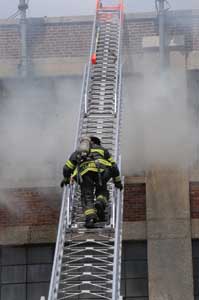 |
| (1) A member makes his way to the roof between the cell phone antennas. Because of the possibility of exposure, limit the time in front of the cell antenna. (Photos 1-3 by Steve White.) |
Operating on a flat-roof building is dangerous, and members on the roof first must find a second way off the roof before starting operations. You always need two ways to evacuate the roof in an emergency. In a building as large as the Staten Island warehouse, consider having a ladder or other means of roof egress on each side of the structure for a safe egress in an emergency or in case of rapid fire development.
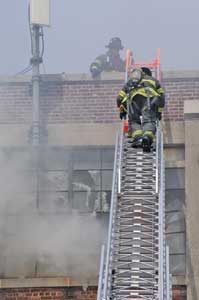 |
| (2) Because of the position of the aerial ladder, the member does not have much room to clear the ladder at the parapet. Therefore, another member is there to assist him off the roof. |
The firefighters on the roof need to bring the proper tools with them, including a working flashlight, a radio, a hook or a pike pole, and a halligan. If the roof is going to be cut, another member going to the roof should bring the saw.
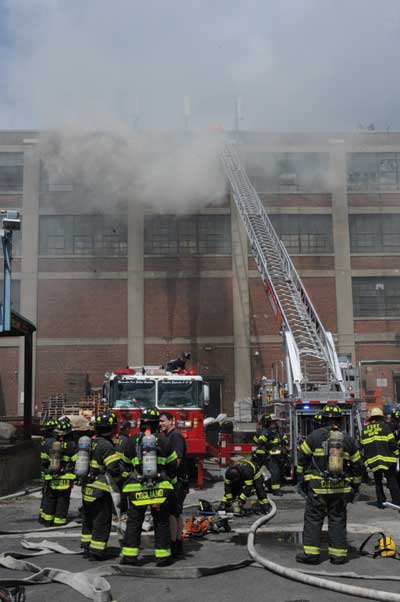 |
| (3) The tower ladder is being set up, and the aerial most likely should be moved away from the smoke so members on the roof have a way off the roof away from the operating tower ladder. |
The most important tool on the roof is a thinking firefighter. Think about the following: What is the roof construction? Is it safe to cut? What are the fire conditions below the roof? Is the roof in danger of collapse? The firefighter on the roof must continually question and evaluate the roof and any venting taking place. If conditions change or the roof becomes soft or spongy, reevaluate the condition of the roof supports. If there is any doubt, start to make your way toward the roof edge. There is more support near the edge, where the roof supports rest on the bearing walls.
If you are blinded by smoke and cannot see, drop to your knees and wait for the smoke to clear. If conditions remain smoky and become untenable and you must leave the roof, retreat the way you came onto the roof, because you know where your emergency egress is. If the IC issues an emergency evacuation order for the roof, then the best way off is always the safest way-not the quickest way. Do not put yourself in danger for speed.
Venting this warehouse is a major undertaking because the roof is so large and the roof team most likely does not know the interior layout of the space unless members have previous knowledge from drills or responses to the building. If the space on the top floor is a large, uncompartmented area, venting the roof can have a major impact on flow paths and smoke and fire movement. You must coordinate and control the ventilation of the fire building. An interior officer on the fire floor or the IC must approve any venting that takes place.
Photos 4-7. In Chicago, Illinois, a three-story multiple dwelling had heavy fire on the top floor. Members initially went to the roof; as conditions changed, the roofing material became involved in fire. New rubberized roofs are very combustible; when exposed to heavy fire from the top floor, the roofing material catches fire.
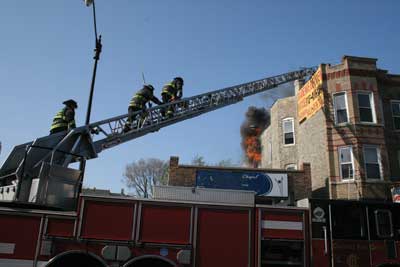 |
| (4) Members of the Chicago (IL) Fire Department make their way to the roof of an isolated three-story multiple dwelling. There is a heavy volume of fire in the rear of the building. (Photos 4-7 by Tim Olk.) |
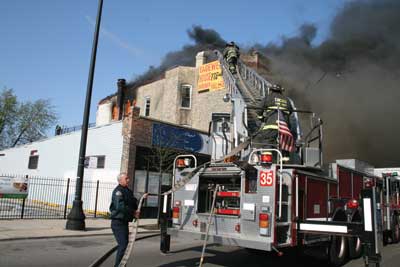 |
| (5) Members are advancing a hoseline to the roof because the roof covering has caught fire. |
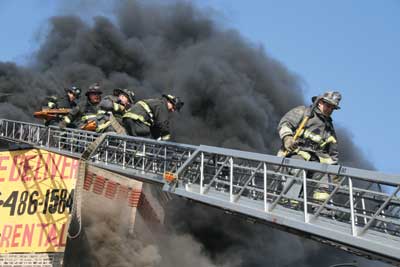 |
| (6) Members are abandoning the roof because of the amount of fire that has taken hold of the roof. |
Members stretched a line up the aerial ladder to extinguish the fire on the roof. Before the line was in place and charged, the roof covering became fully involved. Members evacuated the roof and aerial ladder because of conditions on the roof (photo 7). Members had to wait until the fire was knocked down before heading to the roof again. Because of the nature and age of this building, it is most likely ordinary construction made of wood, brick, and mortar. Because of the type of building, reevaluate the roof support system before recommitting members to the roof. If it is a defensive operation, only commit members to the roof if the support system is safe enough to operate on.
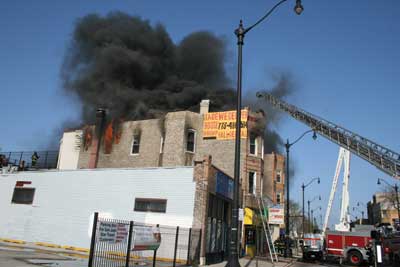 |
| (7) The aerial is being moved because of possible exposure to the fire, and the aerial work platform is being set up; the operation is going defensive. |
The roof is a thinking firefighter’s position; once you have earned the right to be trusted to do the job on the roof, you have to prove you are worthy of this position. Always be ready, informed, and willing to learn. You have the roof!
MICHAEL M. DUGAN is a 27-year veteran of the Fire Department of New York, where he served as captain of Ladder Company 123 before retiring in 2012. As a lieutenant, he served in Ladder Company 42 and was a firefighter in Ladder Company 43. He has been involved with the fire service for 39 years.
Fire Engineering Archives

